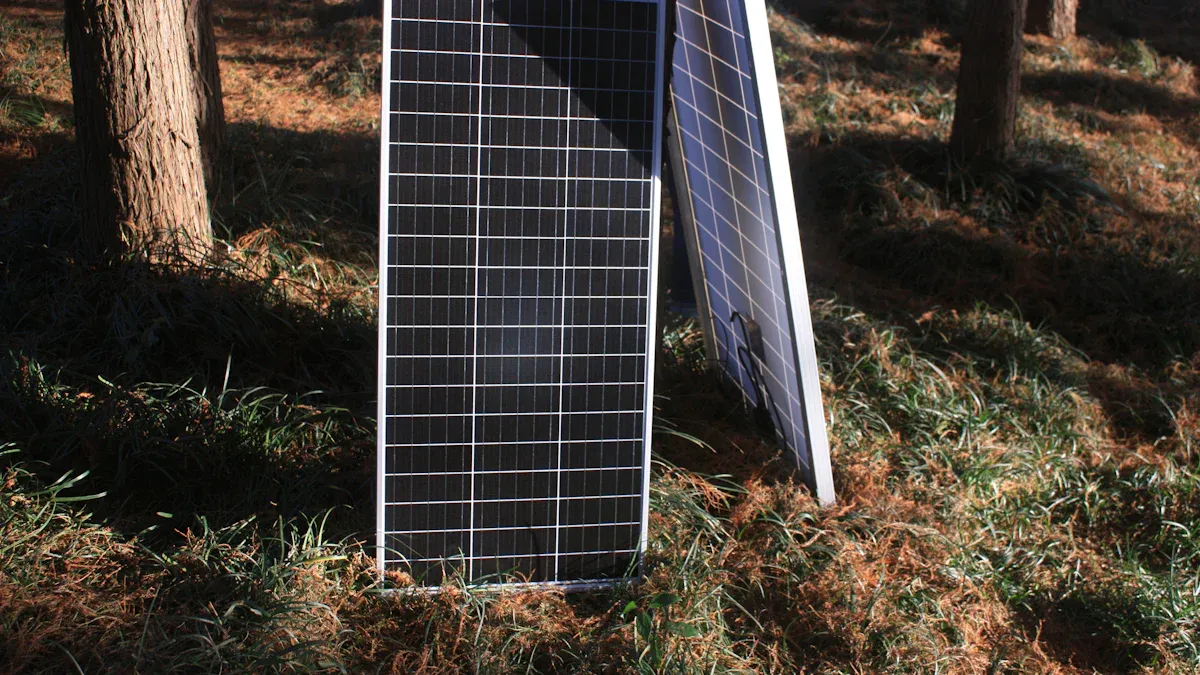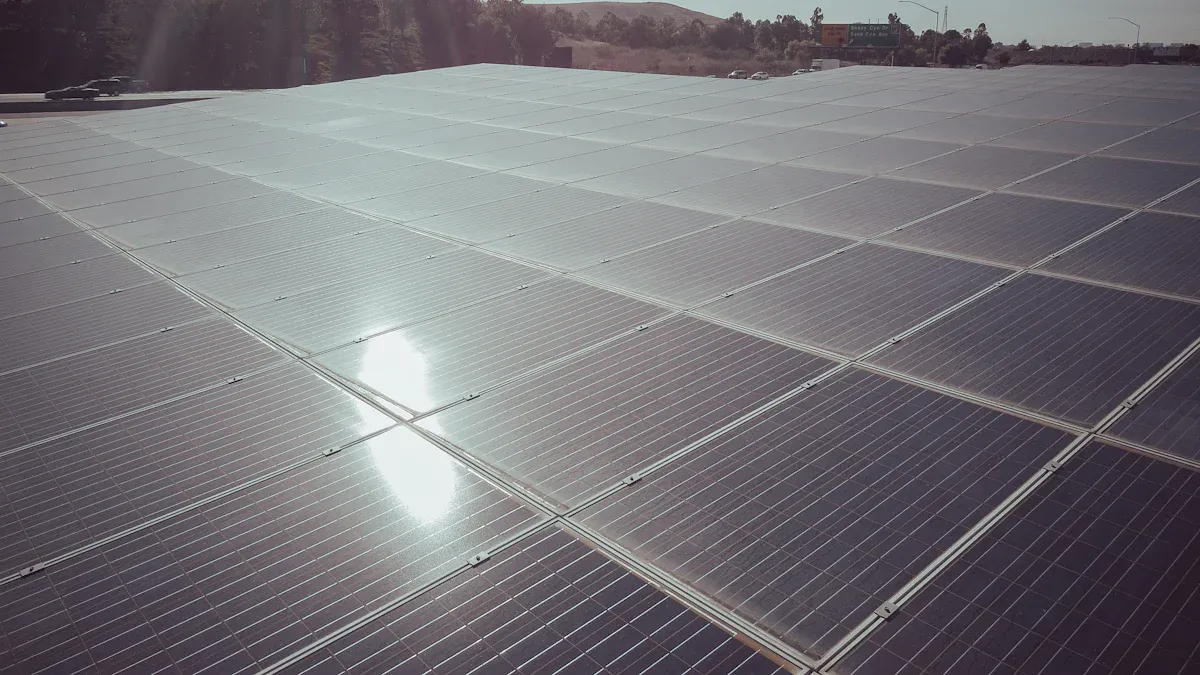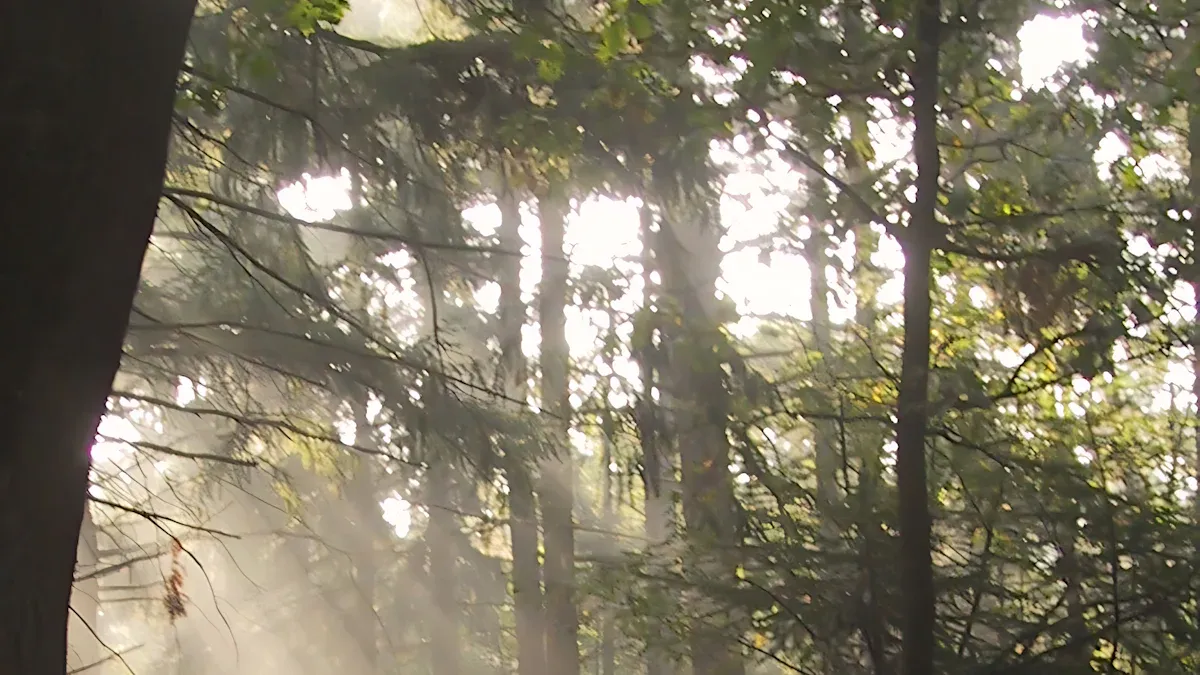Views: 0 Author: @Rice Solar Lighting Publish Time: 2025-07-28 Origin: www.ricesolar.com

Shade from trees blocks sunlight, which solar lights need to charge and work at their best. Even a small shadow can cut charging efficiency by half or more. For example, studies show that partial shading of just 20% can reduce solar panel output by up to 50%. Full shading drops performance to as low as 5-10% of normal. The table below shows how different types of tree shade can impact solar irradiance:
| Source / Study | Tree Type | Season | Solar Irradiance Reduction (%) | Notes |
|---|---|---|---|---|
| McPherson (1984) | Deciduous trees | N/A | Average ~35% (range 25%-50%) | Typical range of irradiance reduction |
| Heisler (1982, 1984) | London plane | Winter | Up to 54% | Measured in center of tree shadow |
| Heisler (1982, 1984) | Pin oak | Winter | Up to 37% | Measured in center of tree shadow |
You can see how shade from trees leads to a dramatic drop in both charging and lighting duration for solar lights.
Shade from trees blocks sunlight and can cut solar light charging by half or more, causing dimmer lights and shorter run times.
Solar lights need 6 to 8 hours of direct sunlight daily for best charging; even partial shade reduces power output significantly.
The 'Christmas light effect' means shade on one part of a solar panel can lower the whole panel’s performance and damage it over time.
Placing solar lights in sunny spots, trimming tree branches safely, and using advanced or high-sensitivity lights improve performance in shaded areas.
For heavy shade, consider solar lights with separate panels, hybrid systems, or wired options to ensure reliable lighting all night.

Solar lights rely on sunlight to generate electricity. When you place a solar light outdoors, the panel on top captures sunlight and begins the charging process. The science behind this process is called the photovoltaic effect. Each solar cell contains two layers of silicon. The top layer, treated with phosphorus, has extra electrons. The bottom layer, treated with boron, creates positive charges. When sunlight hits the panel, photons energize the electrons in the silicon. These energized electrons move toward the positive layer, creating an electric current.
Tip: For best results, position your solar lights where they receive 6 to 8 hours of direct sunlight each day. Less sunlight means slower charging and shorter lighting times.
The amount of sunlight your solar lights receive directly affects how well they charge. Cloudy weather, winter months, or shade from trees can reduce the intensity of sunlight. When this happens, the solar panel produces less electricity, and the battery takes longer to charge. If you set your lights to a higher brightness, they will use more energy and drain the battery faster. Features like motion sensors or dimming options help conserve energy and extend battery life.
The battery inside your solar light stores the electricity generated during the day. At night, the battery releases this stored energy to power the light. Solar lights use different types of batteries, each with unique strengths and weaknesses.
| Battery Type | Advantages | Disadvantages | Typical Use Case |
|---|---|---|---|
| Nickel-Cadmium (NiCd) | Durable, handles extreme temperatures | Memory effect, toxic materials | Older solar lights |
| Nickel-Metal Hydride (NiMH) | Higher energy density, eco-friendly | Less memory effect, moderate lifespan | Modern garden lights |
| Lithium-Ion | High energy density, long lifespan | Higher cost | Compact, high-performance lights |
| Lead-Acid | Affordable, reliable if maintained | Heavy, short lifespan, needs maintenance | Large solar street lights |
Solar batteries act as energy reservoirs. They store extra electricity as chemical energy during sunny hours. When the sun goes down, the battery converts this stored energy back into electricity, keeping your lights on through the night. If your solar lights do not receive enough sunlight, the battery may not fully charge. Over time, repeated partial charging can shorten battery lifespan, especially in older battery types. Consistent, full charging helps maintain battery health and ensures your solar lights work efficiently.

When you place solar lights outdoors, the amount of sunlight they receive depends on how much shade from trees covers them. Full shade happens when tree canopies completely block direct sunlight. In this situation, your solar lights may only receive about 25% of the sunlight they need. This dramatic reduction occurs because tree branches and leaves physically block solar radiation, absorb some of the light, and reflect the rest away from the panel. As a result, your solar lights struggle to charge and may not work at night.
Partial shade is more common in gardens and yards. Here, sunlight filters through gaps in the leaves or branches, creating patches of light and shadow. Laboratory measurements show that even partial shading can cause a sharp drop in power output. For example, if 40% of a solar panel is shaded, you might see a power loss of about 30%. When shading increases to 60-80%, the power loss stabilizes around 36%. Partial shade also causes uneven heating, which can damage the cells over time.
Note: Seasonal changes in tree foliage also affect shading. In summer, dense leaves block more sunlight, while in winter, bare branches let more light through. You should consider how tree growth and seasonal changes will impact your solar lights throughout the year.
The impact of shade from trees on solar lights goes beyond just blocking sunlight. When your solar lights sit in the shade, their panels receive less energy, which leads to shorter lighting times and dimmer output. Even a small amount of shade can cause a significant drop in performance. For example, under partial shade, solar lights typically lose about 11% of their power. If you use advanced technology like DC optimizers, you can reduce this loss to around 6%.
| Condition | Typical Power Loss (%) |
|---|---|
| Partial shade without optimizers | ~11.2 |
| Partial shade with DC optimizers | ~5.7 |
You might think that ambient or reflected light in shaded areas is enough for your solar lights to work well. However, this light is much weaker than direct sunlight. Solar panels need strong, direct rays to charge efficiently. Under dense shade from trees, even the best solar lights will struggle to store enough energy for nighttime use.
Tip: Dappled shade from deciduous trees is less harmful than deep shade from evergreens. If you notice your solar lights underperforming, check if tree branches have grown thicker or if new leaves have appeared.
Solar panels in your lights contain many small cells connected in series. This design means that shade from trees on just one part of the panel can affect the entire system. This problem is known as the "Christmas light effect." Imagine a string of holiday lights: if one bulb goes out, the whole string dims or stops working. The same thing happens with solar panels. If one cell is shaded, it acts as a barrier, reducing the flow of electricity for the entire panel.
Shading on a single cell limits the current for the whole panel.
The shaded cell turns into a resistor, causing energy loss and heat buildup.
Hot spots can form, damaging the panel and shortening its lifespan.
The overall output drops, even if most of the panel remains in sunlight.
This effect explains why even a small patch of shade from trees can cause your solar lights to perform poorly. Modern solar lights sometimes use bypass diodes or microinverters to reduce this problem, but most garden lights do not have these features.
Myth Buster: Some people believe that solar lights need only a little sunlight to work or that shade from trees is not a big deal. In reality, even partial shade can cause major performance issues due to the Christmas light effect.
You can greatly improve your solar lights’ performance by choosing the right spot. Start by mapping sunlight in your yard. Watch the area from 10 AM to 4 PM to find places that get the most direct sunlight. Avoid spots that stay in deep shade from trees, fences, or buildings. Place your solar lights where they receive at least 2 to 4 hours of continuous sunlight each day. In the Northern Hemisphere, point the solar panels south to catch more sun. If your lights have adjustable panels, tilt them to match the sun’s angle as the seasons change. You can also use reflective surfaces, like light-colored walls or sidewalks, to bounce extra light onto the panels. For mobile solar lights, move them to sunny spots during the day for charging. If you have shaded areas, consider mounting the solar panel in a sunny location and running a wire to the light fixture.
Tip: Larger solar panels and higher-capacity batteries help your lights work better in areas with some shade from trees.
Trimming trees safely can reduce shade and boost your solar lights’ efficiency. Always keep a safe distance from power lines to avoid electrical hazards. Hire certified arborists or qualified contractors for major trimming jobs. They use proper methods, like side or “V” pruning, to protect tree health. Trim limbs that hang over your solar lights or block sunlight, and keep a clearance of at least three to four years’ regrowth from the branches. If tree limbs are near power lines, contact your utility company for professional help. Wear gloves when handling solar panels and avoid damaging tree bark when securing lights.
Maintain safe clearance from power lines.
Use certified professionals for large jobs.
Trim branches regularly to prevent new shade from trees.
Contact utility companies for limbs near power lines.
Advanced solar lights offer features that help them perform better in shaded conditions. Look for models with high-efficiency LED bulbs, which use less energy and shine brighter. Choose lights with larger or more efficient solar panels that can capture indirect sunlight. High-capacity rechargeable batteries, such as lithium-ion or nickel-metal hydride, store more energy for longer illumination. Some lights include motion or light sensors to save power by turning on only when needed. Adjustable panels let you angle the solar cells to catch more light, even if some shade from trees is present. Some advanced models even allow USB charging for extra flexibility.
Regular cleaning and trimming nearby vegetation will help your solar lights work their best, even in areas with intermittent shade.
When you face heavy shade from trees, high-sensitivity solar lights can offer better performance than standard models. These lights use advanced photovoltaic (PV) technology and high-quality batteries to improve charging in low-light conditions. You can expect several benefits from these upgraded lights:
Advanced silicon-based PV cells convert indirect or diffuse sunlight into electricity, even when direct sunlight is limited.
Larger or more efficient solar panels collect more light, while energy-saving LED bulbs use less power and shine brighter.
High-capacity batteries, such as lithium-ion or nickel-metal hydride, store more energy and last longer, even with partial charging cycles.
Security solar lights often have bigger panels and batteries, making them more reliable in shaded spots than typical garden lights.
You can angle panels, use reflective surfaces, or trim nearby foliage to boost charging efficiency.
Regular cleaning and battery checks help maintain performance, especially in cloudy or shaded areas.
Tip: Choose solar lights with separate panels. You can place the panel in a sunny spot while keeping the light fixture in the shade.
Although these lights cost more upfront, they save you money over time by reducing electricity bills and maintenance needs. Upgrading to high-efficiency panels and batteries also extends the lifespan of your solar lights, even in less-than-ideal conditions.
In areas with deep or constant shade, you may need to consider hybrid or wired lighting solutions. Hybrid systems combine solar power with grid electricity or allow for supplemental charging through USB or AC outlets. Wired low-voltage LED systems provide reliable lighting regardless of sunlight.
Series wiring of solar panels works better under partial shade than parallel wiring. Bypass diodes let shaded sections be skipped, so you keep more power output.
Higher voltage inputs from series wiring help your system start charging earlier and keep charging longer during the day.
Wired lights offer consistent brightness and longer lifespans, but they require professional installation and may increase energy costs.
Hybrid systems with advanced batteries and supplemental charging options can extend runtime by up to 300% and tolerate partial charging better.
Here’s a quick comparison of solar and wired lighting in shaded areas:
| Aspect | Solar Lights (Advanced/Hybrid) | Wired Electric Lights |
|---|---|---|
| Environmental Benefit | Use renewable energy, lower carbon footprint | Depend on grid power, higher emissions |
| Performance in Shade | Improved with advanced tech, but still limited by sunlight | Consistent, reliable illumination |
| Energy Costs | Low operational costs, no electricity bills | Higher ongoing energy costs |
| Installation | Easy, flexible placement | Requires professional installation |
| Maintenance & Lifespan | Batteries last 3-5 years, panels 10+ years, may degrade in low light | Longer lifespan, more durable, but wiring needs upkeep |
If you want to balance cost, performance, and environmental impact, consider your yard’s shade patterns and choose the solution that fits your needs best.
Shade from trees can dramatically reduce the performance of your solar lights by blocking direct sunlight, which is essential for efficient charging. You can improve lighting by placing solar fixtures in sunny spots, trimming branches, and using multiple lower-lumen lights for balanced coverage. Experts suggest spacing lights along paths and choosing flexible placements to protect tree health. Remember, trees offer valuable cooling and environmental benefits, so aim for a balance between effective solar lighting and preserving your landscape.
If your solar lights get less than two hours of direct sunlight each day, you will see poor performance. Even light shade for part of the day can cut charging by half. Always aim for the sunniest spot possible.
Solar lights can charge on cloudy days or with indirect sunlight, but they work best with direct sun. You may notice dimmer lights and shorter run times during overcast weather. For reliable results, choose high-efficiency models.
Yes! Trimming branches above your solar lights lets more sunlight reach the panels. You will see brighter lights and longer run times. Always trim safely or hire a professional for large trees.
Try these options:
Use solar lights with separate panels you can place in the sun.
Choose hybrid or wired lights for reliable brightness.
Place lights where sunlight is strongest, even if only for a few hours.
